(Peace Memorial Wing)
Acute
In 1919 Watford Urban District Council purchased The Elms and its grounds along Rickmansworth Road as the site of their new Town Hall.
Some 6 acres of the grounds, containing the stable blocks, were sold to be the site of a new hospital which would replace the Watford District Hospital in Vicarage Road.
Work began on the hospital buildings in 1923. The project was funded by public subscription and donations and was intended to be a practical memorial to the losses suffered by local families during WW1. Instead of a War Memorial it was to be built as a Peace Memorial.
The Watford and District Peace Memorial Hospital was officially opened in June 1925 by Princess Mary, Viscountess Lascelles. Built of brick and fireproof concrete and designed in a neo-Classical style, the centre of the front elevation was fitted with white columns, a portico and a pediment. The Hospital had cost £90,000 to build.
Each of the four 2-storey ward blocks had concrete floors and contained two 12-bedded wards. Each ward had 3 private patient rooms and a kitchen attached. A 3-storey building at the rear of the site contained the Nurses' Home.
In 1928 a War Memorial was erected in front of the Hospital. Featuring three symbolic figures in bronze, it had been designed by a local resident, Mrs Mary Pownall Bromet, a pupil of Auguste Rodin. (The War Memorial was removed in 1987 when the road was widened. It is now located beside the Town Hall.)
In 1930 the financier John Pierpoint Morgan, who had a residence (Wall Hall) near Watford, presented the Hospital with 130 bottles of champagne. Since champagne was only prescribed for seasickness and Watford was 70 miles inland, the Hospital Committee was bemused. A local wine merchant was invited to buy the champagne outright. When this produced no response, he was asked to credit the champagne against the Hospital's brandy account. This also failed, and the champagne remained in the Hospital's cellar.
The Hospital was extended in 1937, when a new block with six wards and a Nurses' Home were added.
During WW2 the Hospital became part of the Emergency Medical Scheme (EMS), under the control of University College Hospital (UCH). Its 206 beds were supplemented with 104 EMS beds. In 1941 UCH established Out-Patients and Casualty Departments in one of the wards.
In 1948 the Hospital joined the NHS under the control of the West Hertfordshire Hospital Management Committee, part of the North West Metropolitan Regional Hospital Board. It was renamed the Watford Peace Memorial Hospital.
The Hospital, painted internally with sunshine yellow, had 206 beds (but not all were in use because of staff shortages).
A new Nurses' Home was built in 1948 with a Preliminary Training School for Nurses located in 5 acres of a thickly wooded area (the woods also provided the Hospital with supplies of timber and fuel).
By 1957 the Hospital had 196 beds.
In 1965 it merged with Shrodell's Hospital in Vicarage Road to form the Watford General Hospital, of which it became the Peace Memorial Wing.
The Hospital, with 204 beds, closed in 1985 and the remaining services were transferred to the Shrodells Wing of Watford General Hospital.
Present status (June 2008)
On closure of the Hospital the North West Thames Regional Health Authority announced that it intended to use it for geriatric patients. However, in 1986, most of the outer buildings were demolished and, by 1988, the remainder had become vandalised and derelict.
During public protests in 1991 about the neglected state of the former Hospital, the South West Herts Hospice Charity launched an appeal to raise funds to buy the site for use as a hospice.
In 1993 enough money had been collected to establish a temporary Day Care Centre in a Portakabin beside the Hospital building.
The Peace Hospice opened in 1996.

The main entrance of the administration block of the former Hospital faces Rickmansworth Road, now a major thoroughfare - the A412. The original clock installed in 1924, which was stolen while the property was vacant, has now been replaced by a modern equivalent.
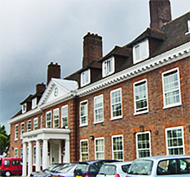
The Locally Listed building has been restored to its former elegance.

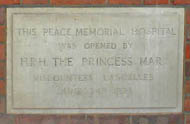
The foundation stone was laid by the Countess of Clarendon, first Mayoress of Watford, in July 1923 (left). A masonry plaque commemorates the opening of the Hospital by Princess Mary in June 1925 (right). Both are located either side of the main front door under the portico.
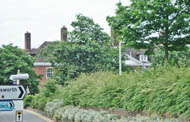
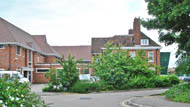
The Hospice, as seen in the distance from Ricksmanworth Road (left). The side of the Hospice on Peace Drive (right).
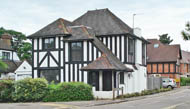

The Hospice is accessed via Peace Drive (left). The Peace Children's Centre in Peace Prospect, at the southeastern part of the site, is managed by the Hertfordshire Partnership NHS Foundation Trust (right).
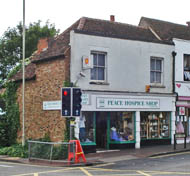
The Peace Hospice Shop in Watford High Street.
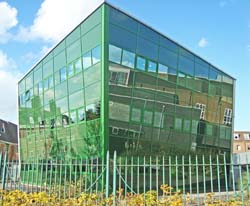
The Peace Children's Centre opened in 2001 beside the former Hospital building. Run by the Hertfordshire Community NHS Trust, it provides specialised children's services for the area.
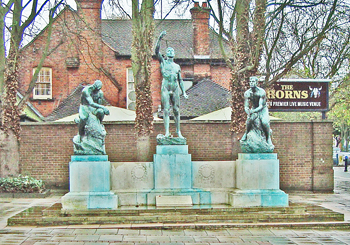
The Grade II listed War Memorial to those who died in two World Wars is now located on the east side of the Town Hall. The left-hand figure is named 'To the fallen', the central one 'Victory' and the right-hand-one is 'To the wounded'.

The tablet states "and in remembrance of all other citizens of this Borough both military and civilian who have given their lives in the service of humanity".
The staining of the Portland stone bases is caused by copper sulphate leaching from the patina of the bronze statues.
The aviation pioneer and aircraft engineer Sir Geoffrey de Havilland (1882-1965) died at the Hospital from a cerebral haemorrhage.
He was the designer of the Mosquito fighter, which was largely made of wood. It is considered the fastest and most versatile warplane to be built during WW2.
(Author unstated) 1941 Medical schools in raided areas. British Medical Journal 2 (4209), 345.
(Author unstated) 1941 Medical news. British Medical Journal 1 (4817), 543.
www.a2a.org.uk
www.geograph.org.uk
www.hertfordshire-genealogy.co.uk
www.ldf.watford.gov.uk
www.nationalarchives.gov.uk
www.time.com
Return to home page